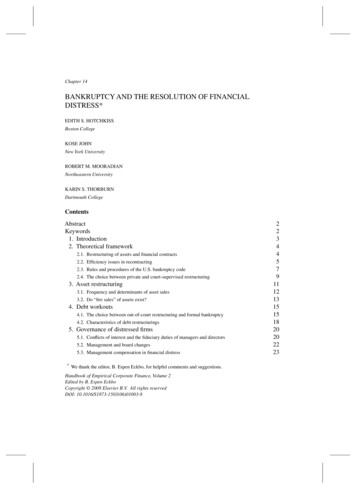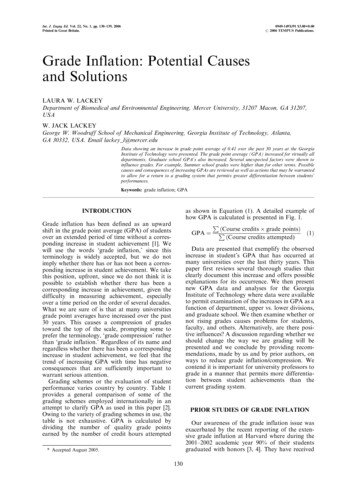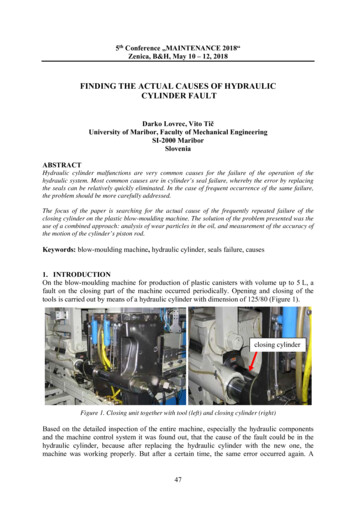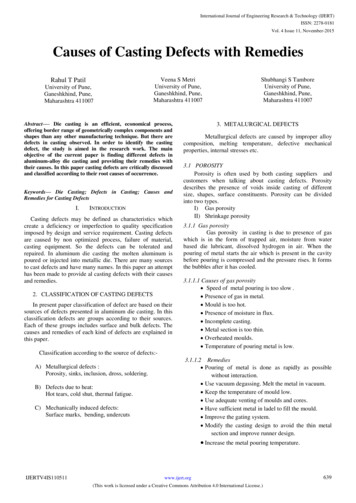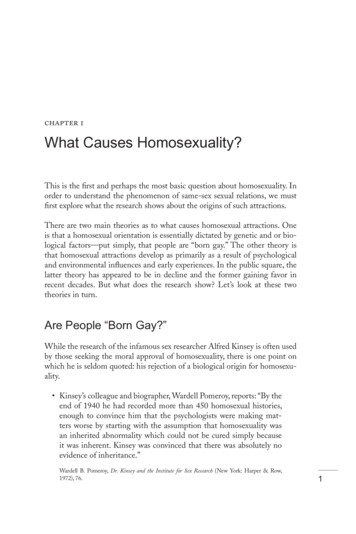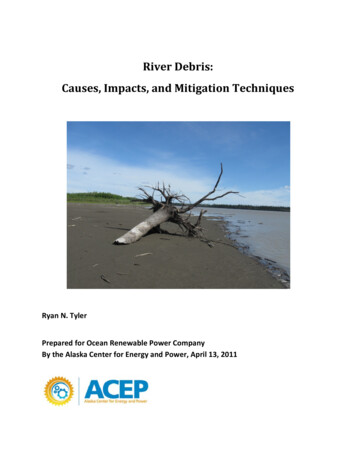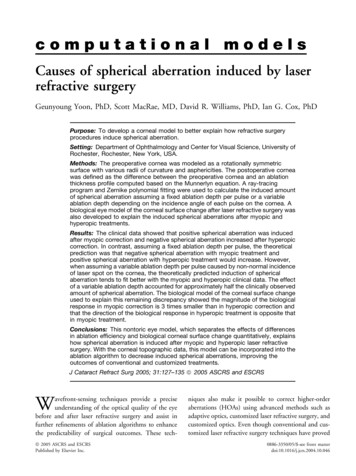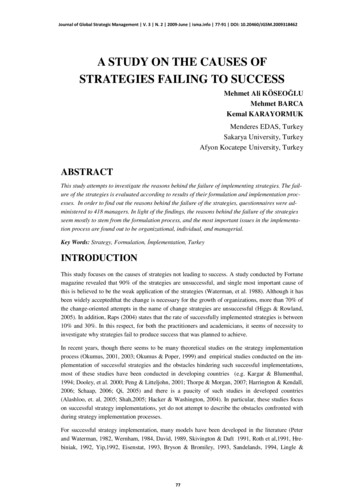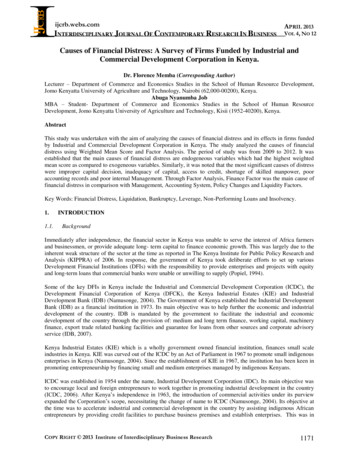
Transcription
ijcrb.webs.comAPRIL 2013INTERDISCIPLINARY JOURNAL OF CONTEMPORARY RESEARCH IN BUSINESSVOL 4, NO 12Causes of Financial Distress: A Survey of Firms Funded by Industrial andCommercial Development Corporation in Kenya.Dr. Florence Memba (Corresponding Author)Lecturer – Department of Commerce and Economics Studies in the School of Human Resource Development,Jomo Kenyatta University of Agriculture and Technology, Nairobi (62,000-00200), Kenya.Abuga Nyanumba JobMBA – Student- Department of Commerce and Economics Studies in the School of Human ResourceDevelopment, Jomo Kenyatta University of Agriculture and Technology, Kisii (1952-40200), Kenya.AbstractThis study was undertaken with the aim of analyzing the causes of financial distress and its effects in firms fundedby Industrial and Commercial Development Corporation in Kenya. The study analyzed the causes of financialdistress using Weighted Mean Score and Factor Analysis. The period of study was from 2009 to 2012. It wasestablished that the main causes of financial distress are endogeneous variables which had the highest weightedmean score as compared to exogeneous variables. Similarly, it was noted that the most significant causes of distresswere improper capital decision, inadequacy of capital, access to credit, shortage of skilled manpower, pooraccounting records and poor internal Management. Through Factor Analysis, Finance Factor was the main cause offinancial distress in comparison with Management, Accounting System, Policy Changes and Liquidity Factors.Key Words: Financial Distress, Liquidation, Bankruptcy, Leverage, Non-Performing Loans and Insolvency.1.1.1.INTRODUCTIONBackgroundImmediately after independence, the financial sector in Kenya was unable to serve the interest of Africa farmersand businessmen, or provide adequate long- term capital to finance economic growth. This was largely due to theinherent weak structure of the sector at the time as reported in The Kenya Institute for Public Policy Research andAnalysis (KIPPRA) of 2006. In response, the government of Kenya took deliberate efforts to set up variousDevelopment Financial Institutions (DFIs) with the responsibility to provide enterprises and projects with equityand long-term loans that commercial banks were unable or unwilling to supply (Popiel, 1994).Some of the key DFIs in Kenya include the Industrial and Commercial Development Corporation (ICDC), theDevelopment Financial Corporation of Kenya (DFCK), the Kenya Industrial Estates (KIE) and IndustrialDevelopment Bank (IDB) (Namusonge, 2004). The Government of Kenya established the Industrial DevelopmentBank (IDB) as a financial institution in 1973. Its main objective was to help further the economic and industrialdevelopment of the country. IDB is mandated by the government to facilitate the industrial and economicdevelopment of the country through the provision of: medium and long term finance, working capital, machineryfinance, export trade related banking facilities and guarantee for loans from other sources and corporate advisoryservice (IDB, 2007).Kenya Industrial Estates (KIE) which is a wholly government owned financial institution, finances small scaleindustries in Kenya. KIE was curved out of the ICDC by an Act of Parliament in 1967 to promote small indigenousenterprises in Kenya (Namusonge, 2004). Since the establishment of KIE in 1967, the institution has been keen inpromoting entrepreneurship by financing small and medium enterprises managed by indigenous Kenyans.ICDC was established in 1954 under the name, Industrial Development Corporation (IDC). Its main objective wasto encourage local and foreign entrepreneurs to work together in promoting industrial development in the country(ICDC, 2006). After Kenya’s independence in 1963, the introduction of commercial activities under its purviewexpanded the Corporation’s scope, necessitating the change of name to ICDC (Namusonge, 2004). Its objective atthe time was to accelerate industrial and commercial development in the country by assisting indigenous Africanentrepreneurs by providing credit facilities to purchase business premises and establish enterprises. This was inCOPY RIGHT 2013 Institute of Interdisciplinary Business Research1171
ijcrb.webs.comAPRIL 2013INTERDISCIPLINARY JOURNAL OF CONTEMPORARY RESEARCH IN BUSINESSVOL 4, NO 12response to the corporation’s new task of assisting the people to participate actively in the economic developmentof their nation (Namusonge, 2004). The table 1.1 shows the list of DFIs in Kenya, the year of incorporation and theproducts they offer.Table 1.1 Development Finance Institutions in KenyaDFIYear DCKIEAFCIDB1965196719691973Products OfferedEquity and loans in medium-and large scale industrial andcommercial projects & Loans for small-scale projectsEquity and loans in SME projects mainly manufacturingManagement of state and private farms and equity and loans inagro- industrial enterprisesEquity and loans in tourism projects and hotel managementDevelopment of industrial estatesProvision of agricultural loansEquity and loans in medium and large scale industrial projectsSource: Njenga, Ngugi and Mwaura (2006)Like in other Sub-Saharan Africa countries, the DFIs were specifically established to alleviate perceived marketfailures in the provision of long-term credit and equity to industrial as well as agricultural enterprises (KIPPRA,2006). Experience shows that Europe was able to go through reconstruction and industrial development because itwas able to access long-term capital from multilateral development institutions. However, unlike some countries,Kenya has not managed to reap significant benefits from DFIs. For example, the Development Bank of Japan,which focuses on the provision of supplement long term funding to qualified infrastructure projects, has shown afavourable performance with a return on equity of 6.5 per cent in 2004. Similarly, the Business Development ofCanada, a leading SME financier in Canada, also has shown encouraging performance with an average return onequity of 7.1 per cent (Ghani, 2005). In South Africa, the Industrial Development Corporation has evolved frombeing a leading industrial player at national level to being the first Africa DFI to have its mandate extended to therest of Africa continent (KIPPRA, 2006). In Kenya, DFIs have experienced several constraints that have madethem not fulfill their mandates. These constraints are political interference, poor performance of projects,inadequate funding and multiplicity of reporting, bureaucracy which slows down decision making process amongothers (KIPPRA, 2006).The many years of DFI mismanagement and lack of adequate funding from government is clearly reflected in thefirms they have funded. For example, in Uchumi Supermarket Ltd, where ICDC has a shareholding of 32%, it hasbeen experiencing financial and operational difficulties occasioned by sub-optimal expansion strategy coupled withweak internal control systems (Uchumi, 2010). Similarly, Agro- Chemical Corporation Ltd, where ICDC has ashareholding of 28.8%, has over the years been unable to service the Government of Kenya guaranteed loan due tofailure in the original business concept. Moreover, 2 ICDC funded firms are under liquidation, 5 under receivership(ICDC, 2006) and 12 are earmarked by Privatization Commission of Kenya (PCK) for privatization due to nonperforming loans or poor performance in general. This is a clear indicator that the firms funded by ICDC areexperiencing financial distress.Financial distress can be defined as a situation in which an institution is having operational, managerial andfinancial difficulties (Adeyemi, 2011). The value of any company reduces through the costs it undergoes during theperiod of distress. Direct costs of insolvency include auditor’s fees, legal fees, management commissions, and otherpayments while indirect costs are those costs related to the action of employees, suppliers, investors andshareholders (Pandey, 2005). Financial distress decreases the incentives of the employees to work hard andstimulates them to renegotiate their compensation packages or to leave the company. Both declining productivityand replacement of employees are costly and destroy the company’s value. Competitors also may pursue anaggressive marketing and price strategy in order to attract customers of the vulnerable company and, therefore,squeeze the troubled competitor out of the market. As a consequence, the distressed company suffers losses in salesleading to a loss of the market share (Natalia, 2007).COPY RIGHT 2013 Institute of Interdisciplinary Business Research1172
ijcrb.webs.comINTERDISCIPLINARY JOURNAL OF CONTEMPORARY RESEARCH IN BUSINESSAPRIL 2013VOL 4, NO 12According to Pandey (2005), suppliers curtail or discontinue granting credit to the firm fearing liquidation.Creditors become less tolerant when a firm faces financial problems. For investors, they are not ready to supplycapital to the distressed firm or they make funds available at high costs and rigid terms and conditions. Nonavailability of funds on acceptable terms could adversely affect the operating performance of the distressed firm.On the other hand, Shareholders may be tempted to undertake risky projects using whatever cash the firm is leftwith. If a risky project succeeds, their gain can be substantial. If the project fails, the creditor will suffer loss.Lastly, the managers generally have a tendency to expropriate the firm’s resources in the form of perquisites andavoid risk. When a firm is under distress, they may have higher temptation to pocket firm’s resources. Managersmay also start making decisions keeping in mind short–term rather than long–term interests of the company. Theymay cut costs that affect the quality of the products and sell productive assets to improve the short – term liquidityof the company. They may pass up profitable investment opportunities to avoid any sort of risk. These sub –optimal decisions will further deepen the problem of a distressed firm, and ultimately cause its liquidation (Pandey,2005).Therefore, financial distress is destructive not only for the financial system of the company, but also it impairs itsorganizational structure, its relationship to external partners and negatively affects the attitudes of the employeestowards their work. The loss of a sufficient amount of financial and human resources is dangerous and can causethe company to liquidate (Natalia, 2007). Thus, financial distress is a huge wastage of funds either directly orindirectly which needs to be detected earlier and possibly be eliminated completely.1.2.Statement of the ProblemAn in-depth review of financial distress literature reveals a considerable attention to financial distress predictionmodels. These models rely much on financial ratios which may not represent all organizational aspects. Moreover,lack of a well developed theory on corporate financial distress that specifies what financial statement ratios or howmany ratios to be incorporated in these models or what weighting approach will best allow assessment of theprobability of distress, has limited the applicability of these models (Beaver, Correia & McNicholas, 2011). Inaddition, the influence of non- accounting or qualitative variables such as management experience , customerconcentration , dependent on one or a few suppliers , level of diversification , qualified audit opinion among othershave not been incorporated in these models in calculating the level of financial distress (Strathmore, 2011). Hence,the results of such empirical works are often inconsistent and impossible to generalize.The influence of underlying non-financial factors both endogeneous and exogeneous have been ignored to thedetriment of many firms. Wholesome studies that relate to the causes of financial distress and that encompasscompany characteristics have not been given proper attention by the concerned stakeholders. This study, therefore,analyzed these causes of financial distress using Weighted Mean Score and Factor Analysis. Identifying thesecauses as earlier as possible definitely prevents a company from being financially distressed. Further, the studyanalyzed the various effects caused when a firm is experiencing distress. It is for this reason, therefore, that thisstudy analyzed the causes of financial distress and its effects while incorporating qualitative variables that areendogeneous and exogeneous to the sample firms funded by ICDC in Kenya.1.3.General Objective of the StudyThe general objective of this study was to analyze the causes of Financial Distress in firms funded by ICDC.1.4.Specific ObjectivesThe following specific objectives were analyzed in sample firms funded by ICDC:1.To identify the nature of the causes of financial distress2.To establish the effects of financial distressCOPY RIGHT 2013 Institute of Interdisciplinary Business Research1173
ijcrb.webs.comINTERDISCIPLINARY JOURNAL OF CONTEMPORARY RESEARCH IN BUSINESS1.5.APRIL 2013VOL 4, NO 12Research HypothesesThe following alternative hypotheses were analyzed in sample firms funded by ICDC:H01: Endogeneous financial distress causes are main causes of financial distressH02: Financial distress affects the firms undergoing financial distress1.6.The Scope of the StudyThe study will consider information from companies that operated during the years 2009 to 2012. This period isappropriate because if it is too long, say 10 years, the study could run the risk of mixing the financial informationfrom companies that operated in different macro – economic contexts. In addition, the researcher decided not toinclude any financial information from companies during the years 2007 and 2008 because that period there was aneconomic crisis which was as a result of political crashes that affected the normal operations of companies in thecountry. This way, the researcher avoids including in the study variations that could bring distortions into the finalanalysis.1.7.Justification of the StudyThe results of this study will be helpful to DFIs and other concerned stakeholders who conduct lending businesses.For financial sector, it could improve the risk return trade – off from investment by not investing in failing business(Gepp & Kumar, 2008). The government and other policy – making institutions will be assisted by the study incoming up with policies that will be beneficial to companies under financial distress. Micro- Institutions, who arecurrently the main financiers to of entrepreneurs, will also benefits by not investing their money in companies thatwill eventually go under. Donors often commit large sum of money in support of development. This study willassist them in choosing companies that are capable in achieving their objectives in development. In addition, thestudy of financial distress will assist DFIs managers in understanding the nature of causes of financial distress andhow they will be able to predict financial distress. Moreover, it will also enable them to improve their performanceand efficiency through better managerial practices. Besides the study being helpful to stakeholders, it will also formthe base for further research.1.8.Limitations of the StudyThe limitation of this study was that some of the firms to be studied were in liquidation process or underreceivership and therefore, the researcher had to rely on the secondary data.2. LITERATURE REVIEW2.1. IntroductionThis chapter provides a detailed review of the literature which focuses on the role of ICDC, financial distressdefinition, theories, and its probable causes and the conceptual framework.2.2. The Role of ICDC in KenyaICDC was established in 1954 as a DFI under the name, Industrial Development Corporation (IDC). Its mainobjective was to encourage local and foreign entrepreneurs to work together in promoting industrial development inthe country (Namusonge, 2004).Commercial activities were introduced immediately after independence whichnecessitated ICDC to change its name from IDC to ICDC. This was in response to the corporation’s new task ofassisting the people to participate actively in the economic development of their nation (KIPPRA, 2006).The mandate of ICDC is to facilitate the industrial and economic development of the country by providing venturecapital finances in a minority capacity; secured long-term loan finance and expert financing and managementadvisory (consultancy) service (ICDC, 2006). To qualify for financial assistance from ICDC, prospective clientsought to be involved in commercial or industrial business ventures, provide security for the loan and have a bankCOPY RIGHT 2013 Institute of Interdisciplinary Business Research1174
ijcrb.webs.comINTERDISCIPLINARY JOURNAL OF CONTEMPORARY RESEARCH IN BUSINESSAPRIL 2013VOL 4, NO 12account where funds will be dispersed. Prospective clients have also to prepare business plans to determine theviability of the project (Namusonge, 2004).2.3. Theoretical Literature2.3.1. Cash Management TheoryCash management theory is concerned with the managing of cash flows into and out of the firm; cash flows withinthe firm and cash balances held by the firm at a point of time by financing deficit or investment surplus cash. Shortterm management of corporate cash balances is a major concern of every firm. This is so because it is difficult topredict cash flows accurately, particularly the inflows, and there is no perfect coincidence between cash outflowsand inflows (Aziz & Dar, 2006). During some periods cash outflows will exceed cash inflows because paymentsfor taxes, dividends or seasonal inventory will build up. At other times, cash inflow will be more than cash salesand debtors may realize in large amounts promptly (Pandey, 2005). An imbalance between cash inflows andoutflows would mean failure of cash management function of the firm. Persistence of such an imbalance may causefinancial distress to the firm and, hence, business failure (Aziz & Dar, 2006).2.3.2. Credit Risk TheoryCredit is the provision of goods and services to a person or entity on agreed terms and conditions where thepayments are to be made later with or without interest. During the contract period, not all debtors will repay theirdues as and when they fall due. When the debtor does not pay their dues on the due date, the lender is exposed tocredit risks which may in turn lead to default. Credit risk is therefore the investor’s risk of loss, financial orotherwise, arising from a borrower who does no pay his or her dues as agreed in the contractual terms (Nyunja,2011).2.3.3. Entropy TheoryAccording to the Entropy Theory (or Balance Sheet Decomposition Measure Theory), one way of identifyingfirms’ financial distress could be a careful look at the changes occurring in their balance sheets (Aziz & Dar, 2006).This theory employs the Univariate Analysis (UA) and Multiple Discriminant Analysis (MDA) in examiningchanges in the structure of balance sheets. Univariate Analysis is the use of accounting based ratios or marketindicators for the distress risk assessment (Natalia, 2007). The financial ratios of each company, therefore, arecompared once at a time and the distinction of those companies through a single ratio with a cut – off value is usedto classify a company as either distressed or non- distressed (Monti & Moriano, 2010). MDA (or MultivariateStatistic or Multivariate analysis) is a statistical analysis in which more than one variable are analyzed at the sametime (Slotemaker, 2008). The aim of MDA is to eliminate the weakness of univariate analysis. First, single ratioscalculated by univariate analysis do not capture time variation of financial ratios. This means that accounting ratioshave their predictive ability one at a time, and it is impossible to analyze, for instance, rates of change in ratios overtime. Second, single ratios may give inconsistent results if different ratio cla
Commercial Development Corporation in Kenya. Dr. Florence Memba (Corresponding Author) . were improper capital decision, inadequacy of capital, access to credit, shortage of skilled manpower, poor . has limited the applicability of
